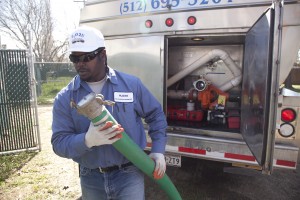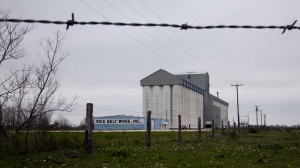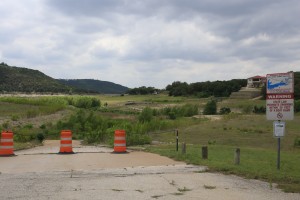LCRA Raises Water Rates For Some Customers

Graphic by Todd Wiseman/Texas Tribune
The Lower Colorado River Authority has to meet Central Texas Water demands even as the supply dwindles.
As summer sets in and drought drags on, the growing burden of a strained water supply is weighing on Texans in the Lower Colorado River Basin.
The board of directors for the Lower Colorado River Authority (LCRA), the quasi-state organization that controls water from that basin, voted unanimously on Wednesday to raise water prices for some customers and to not release water downstream to farmers for a third consecutive year.
“The drought rate is needed to cover our cost during the drought when we’re selling less water to many of our customers and other utilities that have large fixed costs that don’t change based on the weather,” said John Hofmann, Executive Vice President of Water at LCRA.
The City of Austin and a South Texas nuclear power plant – the LCRA’s two largest firm water customers — will not see rates increase. Interruptible customers in the Gulf Coast and Lakeside irrigation divisions will also see no changes to water prices, but they will also receive no water this year.
Higher prices add to pressure on many communities, said Donna Klaeger, District Judge of Burnet County, where wells have dried, lake shores have receded, and the town of Spicewood Beachd has had to have water trucked in every day since 2011.

Photo by Jeff Heimsath/KUT
A water hauler prepares pump water into Spicewood Beach's system after the town's well went dry in 2011.
“Home values are now cut in half, and people are trying to sell their houses because they’re not on a lake anymore. They’re dealing with water issues, devaluation of their homes, the requirement to curtail water and now they’re dealing with the very large increase in the cost of the water,” said Klaeger.
Water rates will rise in 2015 for municipal and industrial customers by about 14 percent, from $151 to $175 per acre-foot, and return to the original rate in 2016. Garwood customers, primarily rice farmers, will pay $37.37 per acre-foot.
The LCRA defended the rate hikes by saying it bears the burden and costs of maintaining elaborate water supply infrastructure, even when customers can’t buy water. Now the LCRA stands to lose another year of revenue from selling irrigation water to farmers whose contracts do not allow them to buy water under current drought conditions under the 2010 water management plan.
Most rice farmers in Wharton, Matagorda, Fayette and Colorado counties have lost two years of crops since the water supply has been unable to meet massive demands of flooding hundreds of rice fields. Insurance has padded losses, but a third year of benefits might not come, says Ronald Gertson, rice farmer and chair of the Colorado Water Issues Committee. If farmers lose insurance, it could mean the end for rice farming in the region.

Photo by Jeff Heimsath/StateImpact Texas
Rice mills and drying and storage facilities in Southeast Texas haven't been seeing much business in the two years that farmers haven't gotten irrigation waters.
“We will see more businesses go bankrupt. We will see an older generation of farmers begin retiring and attempting to sell-off equipment,” Gertson said. “How that equipment will be sold when other farmers aren’t farming either – I don’t know.”
The LCRA has been hard-pressed to manage water for over one million Texans as dwindling rains and persistent heat have lowered reservoirs. In September 2013, storage in the Highland Lakes fell to its lowest level since Texas’ record drought of the 1950s.
Jo Karr Tedder, President of the Central Texas Water Coalition, which represents interests on the Highland Lakes, has in recent years called for buying out rice farmers along the Lower Colorado and using the land for less water-intensive crops instead. Rice farming in the region uses between two to three times as much water from the Highland Lakes as the City of Austin each year. She told the LCRA board this week that the price hike means upstream customers were funding costs for unnecessary canal infrastructure downstream.*
“We represent many firm customers – counties, municipalities, water supply companies, businesses and firm domestic contracts,” she said to the LCRA board. “And all of our firm customers feel that the $175 acre-foot is unfair and discriminatory.”
The City of Austin is exempt from a rate increase because it prepaid for its water in a 1999 contract. “Interruptible” customers downstream pay just a fraction of what “firm” municipal and industrial customers pay, but interruptible contracts allow for cut-offs when the reservoirs pass below certain thresholds. Firm contracts guarantee a water supply.
“[There is a] greatly reduced value of a water supply that can and has been cut off completely. The value of water for economic development is proportional to its reliability,” said Gertson.
Downstream farmers contend that they are forced to give up their livelihood and have suffered too much of the burden of drought. The Lower Colorado River Basin Coalition, LCRBC, represents lower basin agricultural interests in the water debate and got a big boost when the City of Bastrop joined its members on Monday.
“The farmers have been cut off for three years, there’s been no water to water their crop, and yet in Austin we’re seeing that folks are able to still water lawns,” said LCRBC spokesman and biologist Kirby Brown, “We’re not seeing equitable sacrifices across the basin at this point and we’d like to see that.”
In 2013, the LCRA requested permission from the Texas Commission on Environmental Quality (TCEQ) to raise the threshold reservoir level above which irrigation water could be supplied, from 850,000 to 1.1 million acre-feet, but the request was denied.

Dylan Baddour/StateImpact Texas
The public boat ramp at Cypress Creek Park on Lake Travis has been out of use since the water receded past its end in 2011. Since then, the entire lagoon on which the park is situated has dried.
The combined storage of the Highland Lakes is currently at 40 percent and is expected to fall throughout the summer, though some forecasts say a likely El Niño event coming this fall could bring substantial relief to drought-stricken Texas. If combined storage of the Highland Lakes falls below 30 percent capacity, the LCRA will instate mandatory 20 percent curtailment of all firm customers’ water use. The City of Austin has already met that target.

